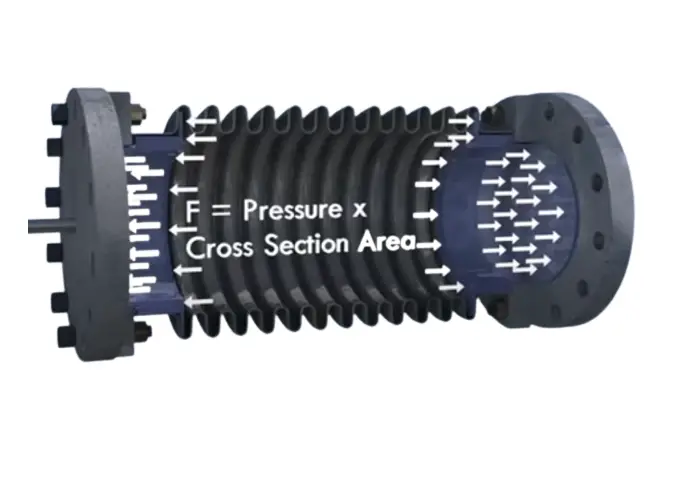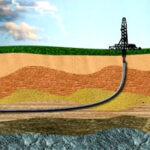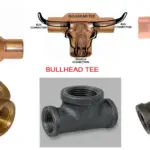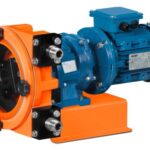Pressure thrust is the thrust force generated by the fluid pressure. This force exists in all pressurized piping systems. Pressure thrust acts at directional changes like elbows, and tee connections, and at pipe and pipeline cross-sectional changes like reducers. It behaves as pipe longitudinal force or axial force and on high-pressure piping systems this force can be significant. In this article, we will discuss Pressure thrust forces in pipeline and piping systems and expansion bellows.
Pressure Thrust Formula
As already mentioned above, the pressure thrust in a piping system is generated by the internal piping pressure. The calculation of pressure thrust is quite easy. The Pressure thrust is calculated by multiplying the internal gage pressure by the pipe’s internal cross-sectional area. Hence, the Formula for Pressure Thrust can be written as:
Pressure Thrust, T= Pipe Design Pressure (P) X Pipe Internal Cross Sectional Area (A)
Piping design pressure, P is taken from the process line list or line designation table.
The internal cross-sectional area of the pipe can be calculated as
A=(π*Di2)/4
Where Di=Pipe Internal Diameter=(Pipe Outer diameter-2*Thickness)
So, you can easily evaluate the magnitude of pressure thrust that can be generated by pressure in a piping system or component. Using the same pressure thrust equation, pressure thrust calculators can be easily developed.
Types of Pressure Thrust
There are two types of Pressure Thrust that can act on a piping or pipeline system. they are:
- Static Pressure thrust, and
- Dynamic Pressure thrust.
The normal pressure thrust that occurs in a pipe whenever it is pressurized is called the static pressure thrust. On the other hand, dynamic pressure thrust occurs due to the momentum of fluid moving through a pipe. In general, dynamic pressure thrust force is relatively small as compared to static pressure thrust force when the flow velocity is less. Dynamic pressure thrusts become a cause of concern only when the flow velocity is very high as in the case of water hammer or surge.
Is Pressure Thrust a concern for Piping and Pipeline Systems?
In a welded pipework, the pressure thrust does not pose any concern as the static tensile force that acts on the directional changes increases the length of the piping/pipeline system slightly. For piping systems, the increase in length is usually very less, but for long distant pipeline systems, the effect of increased length due to static pressure thrust force is considered in the form of the bourdon effect in most pipe stress analysis software packages.
For unrestrained pipeworks (like a spigot and socket pipes) where each pipe piece is not fixed to each other, the pressure thrust force can push the joints apart and must be mitigated to prevent leakage/ failure of the system.
In general, thrust blocks are used to manage the pressure thrust forces for unrestrained pipeworks. Thrust blocks take care of the pressure thrust force and pipe movement and prevent the pipework from failing.
What is Pressure Thrust in an Expansion Bellow?
The pressure thrust in a bellow is the force created by pressure acting on the bellow. Bellows pressure thrust is one of the important parameters that must be considered during the design phase. If the pressure thrust in an unrestrained bellow is not suitably taken care then the force will tend to pull the ends away from the expansion joint causing damage to the whole system as well as the bellows. So, the thrust force must be absorbed by providing proper anchors and guides in the system. Studies have shown that the majority of the unrestrained expansion bellow failures account for improper consideration of bellow pressure thrust. Refer to Fig. 1 below that explains the pressure thrust on typical bellows.

For restrained bellows/ tied expansion joints the pressure thrust is contained within the bellow assembly by the tie rods (or hinges/gimbals).
When an unrestrained expansion joint is positioned near the equipment nozzles, the pressure thrust force will be transferred to the equipment nozzle if suitable anchor support is not provided. Sometimes, tied expansion bellows with a gap are provided near equipment nozzles assuming that the expansion joint will take care of the axial thermal expansion and tie rods will bear the pressure thrust force. But I feel the approach is not correct, as during operating conditions when the expansion joint is compressed the pressure thrust force will be transferred to the equipment nozzle.
Calculation of Pressure Thrust Force of Expansion Joint
The pressure thrust force for an expansion bellows is calculated as follows:
Pressure Thrust = P * Aeff
Here,
- P=Design Pressure
- Aeff=Effective bellow area based on mean bellow diameter, Dm
- Dm= (Bellows ID + Bellows OD)/2
The effective ID or mean diameter can be found on most of the expansion joint catalogs. Based on the above formula for pressure thrust, various online pressure thrust calculators are prepared that make the life of expansion joint users very easy by calculating the magnitude of the pressure thrust.
Pressure Thrust Force Calculation on Equipment Nozzles
When an unrestrained bellows expansion joint is used in a pipe connected to an equipment nozzle, there is a pressure thrust load acting on the nozzle. That pressure thrust force on the nozzle can be calculated as:
Thrust Force on the Equipment Nozzle=P*π*(Dm2-d2)/4
Here, d is the inside diameter of the nozzle.
However, The equipment foundation must resist the entire pressure thrust load of P*(π*Dm2)/4.
To avoid the transfer of pressure thrust to equipment nozzles, it is preferable to use pressure-balanced expansion joints. That will absorb the thermal movement and at the same time resist the pressure thrust force.







Ι like thе vaⅼuable info you provide ᧐n your articles.
I’ll bօokmark your weblog and test once more here regularly.
I’m moderately sure I’ll be told many new stuff proper right here!
Good luсk for tһe next!